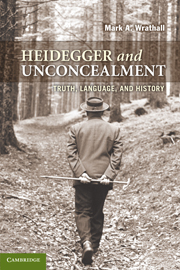Book contents
- Frontmatter
- Contents
- Acknowledgments
- Credits
- Introduction
- Part I Truth and Disclosure
- Part II Language
- 5 Social Constraints on Conversational Content: Heidegger on Rede and Gerede
- 6 Discourse Language, Saying, Showing
- 7 The Revealed Word and World Disclosure: Heidegger and Pascal on the Phenomenology of Religious Faith
- Part III Historical Worlds
- Works by Heidegger
- Index
- References
5 - Social Constraints on Conversational Content: Heidegger on Rede and Gerede
Published online by Cambridge University Press: 05 June 2012
- Frontmatter
- Contents
- Acknowledgments
- Credits
- Introduction
- Part I Truth and Disclosure
- Part II Language
- 5 Social Constraints on Conversational Content: Heidegger on Rede and Gerede
- 6 Discourse Language, Saying, Showing
- 7 The Revealed Word and World Disclosure: Heidegger and Pascal on the Phenomenology of Religious Faith
- Part III Historical Worlds
- Works by Heidegger
- Index
- References
Summary
Introduction
What role does one’s community play in determining one’s meaning – in fixing the content of what is available to individual members of that community to do or to say? Heidegger, for one, has argued that our activities are heavily constrained by social factors. We always act within a public realm, which is already organized and interpreted in a determinate way. As a consequence, Heidegger explains, we are “constantly delivered over to this interpretedness, which controls and distributes the possibilities” available to us for action (GA 2: H. 167). Indeed, Heidegger argues that our being “delivered over” to the public interpretation of things is an inescapable feature of human existence. What is true of action in general is also true for our use of language. Heidegger claims that in language itself there is hidden an “understanding of the disclosed world” (GA 2: H. 168). So not just our possibilities for practical engagement with the things and people around us but even the possible range of what we can say is subject in some way to others.
One consequence of social constraints on language, Heidegger believes, is a tendency on the part of speakers to fall into a superficial imitation of the kinds of things that others in their linguistic community say. He calls such speech Gerede, which is generally translated as “idle talk.” Gerede is the everyday mode of Rede, which is generally translated as “discourse.” For reasons to be explained later, I will translate Rede as “conversation,” and Gerede as “idle conversation.” Heidegger tells us that in idle conversation, one understands things “only approximately and superficially”: “one does not so much understand those entities about which one converses [das beredete Seiende], but rather one listens only to what is said in the conversation as such [das Geredete als solches]” (GA 2: H. 168). Or, as he puts it elsewhere, this kind of idle conversation “releases one from the task of true understanding” (GA 2: H. 169).
Information
- Type
- Chapter
- Information
- Heidegger and UnconcealmentTruth, Language, and History, pp. 95 - 118Publisher: Cambridge University PressPrint publication year: 2010
